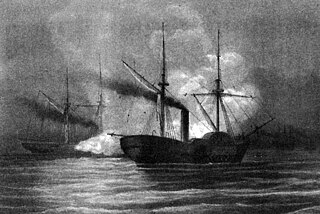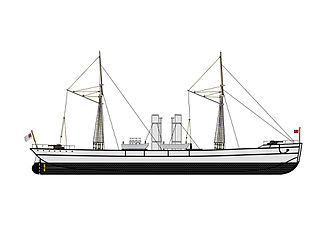
The very first USS Hatteras was a 1,126-ton iron-hulled steamer purchased by the Union Navy at the beginning of the American Civil War. She was outfitted as a gunboat and assigned to the Union blockade of the ports and waterways of the Confederate States of America. During an engagement with the disguised Confederate commerce raider, CSS Alabama, she was taken by surprise and was sunk off the coast of Galveston, Texas. The wreck site is one of the few listed on the National Register of Historic Places because of its location away from destructive surf and because of the ship's side-wheel design, which marks the transition between wooden sailing ships and steam-powered ships.

USS Santee (1855) was a wooden-hulled, three-masted sailing frigate of the United States Navy. She was the first U.S. Navy ship to be so named and was one of its last sailing frigates in service. She was acquired by the Union Navy at the start of the American Civil War, outfitted with heavy guns and a crew of 480, and was assigned as a gunboat in the Union blockade of the Confederate States. She later became a training ship then a barracks ship for the U.S. Naval Academy.

Harriet Lane was a revenue cutter of the United States Revenue Cutter Service and, on the outbreak of the American Civil War, a ship of the United States Navy and later Confederate States Navy. The craft was named after the niece of senator and later United States President, James Buchanan; during his presidency, she acted as First Lady. The cutter was christened and entered the water for the Revenue Service in 1859 out of New York City, and saw action during the Civil War at Fort Sumter, New Orleans, Galveston, Texas, and Virginia Point. The Confederates captured her in 1863, whereupon she was converted to mercantile service. Union forces recaptured her at the end of war. The US Navy declared her unfit for service and sold her. New owners out of Philadelphia renamed her Elliot Ritchie. Her crew abandoned her at sea in 1881.

USS South Carolina (1860) was a steamer used by the Union Navy during the American Civil War.

America was a 19th-century racing yacht and first winner of the America's Cup international sailing trophy.

USS Kennebec was a Unadilla-class gunboat built for the U.S. Navy following the outbreak of the American Civil War. She was named for the Kennebec River.
See also USS Sam Houston (SSBN-609).

The CSS Tallahassee was a twin-screw steamer and cruiser in the Confederate States Navy, purchased in 1864, and used for commerce raiding off the Atlantic coast. She later operated under the names CSS Olustee and CSS Chameleon.
The second Navy vessel to bear the name Sachem, this screw steamer was built in 1844 at New York City, where it was purchased by the Navy on 20 September 1861.
USS Rachel Seaman was a wooden schooner purchased by the Union Navy during the American Civil War.

USS Morning Light (1853) was a sailing ship acquired by the Union Navy during the American Civil War. She was used by the Navy to patrol navigable waterways of the Confederacy to prevent the South from trading with other countries.
USS William G. Anderson (1859) was a barque used by the Union Navy during the American Civil War. She was assigned by the Navy to patrol navigable waterways of the Confederacy to prevent the South from trading with other countries.
USS Corypheus (1862) was a schooner captured by the Union Navy during the American Civil War.
USS Arthur was a bark acquired by the Union Navy during the American Civil War. She was used by the Union Navy as a gunboat in support of the Union Navy blockade of Confederate waterways.
USS G. W. Blunt was a Sandy Hook pilot boat acquired by the Union Navy during the American Civil War in 1861. See George W. Blunt (1856) for more details. She was used by the Union Navy as a gunboat as well as a dispatch boat in support of the Union Navy blockade of Confederate waterways.

USS Hope (1861) was a 19th-century wooden yacht schooner, designed and built in 1861 by Henry Steers for Captain Thomas B. Ives of Providence, Rhode Island. She was acquired by the Union Navy during the American Civil War. She was placed into service as a gunboat assigned to support the fleet blockading the ports of the Confederate States of America. However, at times, Hope was assigned extra tasks, such as that of a dispatch boat, supply runner and salvage ship. She was a pilot boat from 1866 to 1891 and in 1891 she was replaced by the Herman Oelrichs, when the Hope was wrecked ashore the Sandy Hook Point.
The Texas Marine Department (1861–1865) was formed in the State of Texas shortly after Texas came under blockade from the Union Navy in 1861. It operated under the control of the Confederate Army during the Civil War.

George W. Blunt, completed in 1856, was a schooner built in New York that operated as a New York Sandy Hook pilot boat designated Pilot Boat No. 11. The schooner was used to pilot vessels to and from the Port of New York and New Jersey. That schooner was sold to the United States Navy in 1861, renamed and commissioned as the USS G. W. Blunt (1856), serving in the South Atlantic Blockading Squadron in the South. A second schooner, also named George W. Blunt, was built in East Boston in 1861 and purchased to replace the first schooner as a pilot boat.
CSS General Rusk, built as a merchantman at Wilmington, Del., in 1857, was seized from the Southern Steamship Co., by the State of Texas at Galveston in 1861. She served as reconnaissance and signal boat with the Texas Marine Department in and about the waters of Galveston Harbor during the latter half of 1861, trying unsuccessfully on several occasions to slip past the Federal blockade. In early November 1861 she rendered aid to Royal Yacht following that vessel's capture and firing by Union forces from USS Santee, and managed to save her from complete destruction and tow her to safety. In December 1861 she was ordered to take part in the defense of Buffalo Bayou, San Jacinto River.










